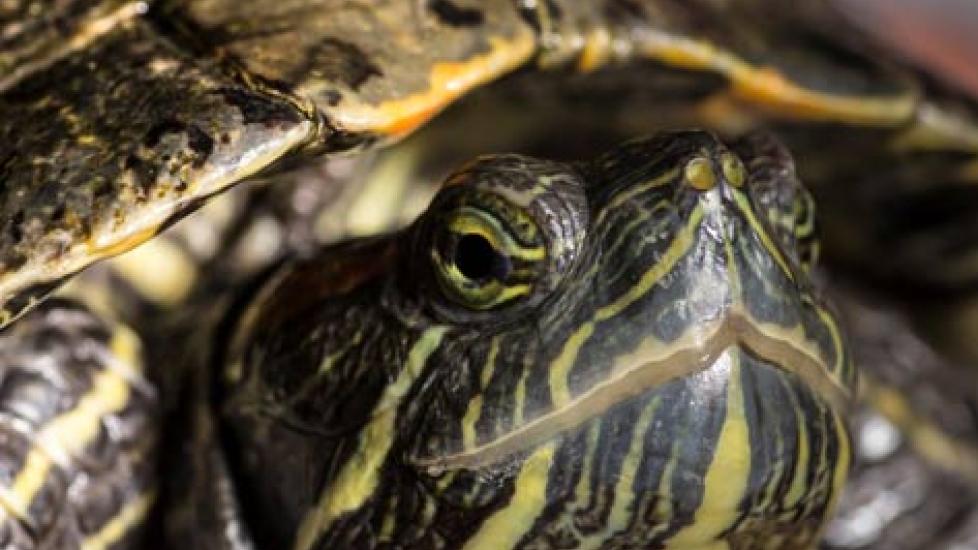How to Tell a Turtle’s Age
By David F. Kramer
Turtles and tortoises are among the longest living animals in the world. A decision to own one as a pet could very well include a lengthy commitment, perhaps even as far as making allowances for your reptile friend’s care in your will. Whether or not you need the help of your attorney, a turtle or tortoise is bound to be a pet you’ll enjoy for years to come.
Dr. Jennifer Coates, veterinary advisor with petMD, says that Jonathan, a Seychelles giant tortoise who lives on the island of Saint Helena, holds the current longevity record for a living tortoise. “It seems likely that he was hatched around 1832,” she says, adding that different species of turtles and tortoise have varied lifespans, but “with good care, many types of pet turtles can be expected to live between 30 and 40 years, while box turtles and tortoises generally have a life expectancy of 50 to 100 years.”
Dr. Adam Denish of Rhawnhurst Animal Hospital in Pennsylvania has seen, up close and personal, just how long some turtles can survive.
“I actually have a tortoise client in my practice that has an amazing history with their family pet. They own a tortoise that was living in Queen Victoria's gardens in the 1880s in London,” he says. “They have direct provenance to account for the age of the tortoise. If you saw this amazing 52 pound animal, you would assume it was old by its shell, but never would you think it would be over 130 years old.”
Many turtle owners are undoubtedly curious as to the age of their pets. Unfortunately, short of being present when they hatch, there really is no definitive way to know how old they are. There are, however, a variety of ways to approximate a turtle’s age and make some fairly educated guesses that might satisfy a pet owner’s curiosity. It’s not difficult to do, and it simply involves taking a good long look at your reptile companion, as well as its living environment.
Comparing the size of your turtle to one of the same species as an adult is good start. Smaller individuals tend to be younger but a lot of outside influences can have an effect on a turtle’s growth rate, so this simple check is by no means certain. Coates adds that “females tend to grow larger than males,” so this will also need to be taken into account.
If your turtle was bred in captivity, you can probably shave a few years off its age as turtles tend to grow much faster when their diet is rich and they are well cared for. Turtles will only be able to breed once they reach maturity, so knowing if your turtle has ever bred can also help approximate its age. Turtles generally reach maturity between 5 to 8 years of age, and for tortoises it can be as many as 20 years to reach full maturity.
Much like the rings on the trunk of a tree, as a turtle ages it develops rings in its scutes, the plates that make up its shell. However, simply counting them and assuming each one represents a year would be a mistake, says Coates. She explains that the rings on a turtle denote periods of growth rather than lengths of time. In some years, a turtle may grow a great deal, and in others it may grow very little, if at all. A ring could indicate a growth spurt, even if this took very little time over the life of a turtle.
As a turtle lives, the time and elements do take their toll on a its shell and skin, even if it has spent its life in captivity. Dents, chips, or discoloration on the shell might be symptomatic of a long life, but it could also be the result of a single tumble out of a tank, or even from the basking place of a young turtle.
According to Denish, a visit to your veterinarian can help you to estimate the age of your pet turtle or tortoise. “I see at least a few tortoises a month that are so badly deformed from previous disease that they look old. The conformation of the shell, the quality of the scutes, the color of the shell, and the texture of the skin and shell are all signs that allow me to guess the age of the animal.”
But again, even from a veterinary standpoint, that’s still just a guess. So, is knowing your turtle’s age all that important? Denish says no.
“In truth, it only matters in a few circumstances. First, if breeding is going to be considered, it will allow you to know when the pet can be bred. Second, it helps you to know what size that turtle will be when an adult. That helps you to make sure that you have an appropriately sized enclosure for that pet. Finally, it helps in some species when you need to know the proper diet for a newborn, a juvenile, an adult, or a geriatric. To me, it is most important to research the species you are considering to make sure it is appropriate for you regarding temperament, size, care requirements, and costs.”
